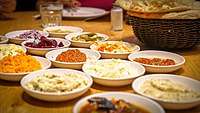Lahmacun
Lahmacun (also lahmajun and other spellings) is a round, thin piece of dough topped with minced meat (most commonly beef or lamb), minced vegetables and herbs including onions, tomatoes and parsley, and spices such as cayenne pepper, paprika, cumin and cinnamon, then baked.[5] Lahmacun is often wrapped around vegetables, including pickles, tomatoes, peppers, onions, lettuce, parsley, and roasted eggplant.[6][7][8][9]
 Lahmacun with salad | |
| Alternative names | Lahm b'ajin, lahamagine, lahmajun, lahmajoun[1][2] |
|---|---|
| Course | main |
| Place of origin | Middle East[3][4] |
| Serving temperature | warm |
| Main ingredients | Minced meat, vegetables and herbs |
Though it is sometimes described as Turkish pizza,[10] Armenian pizza,[4] or similar names, it has only in modern times been referred to as "pizza", and it is of Middle Eastern rather than European origin. Furthermore, unlike pizza, lahmacun is not usually prepared with cheese[11] and the crust is thinner.[12]
Lahmacun is a popular dish in Armenia,[11] where it is also called lamadjo;[13] in Turkey (lahmacun), Lebanon and Syria (lahm bi 'ajin)[14][15]), Israel,[13] and Armenian and Turkish communities,[11] and Arab, worldwide.
Etymology
The name entered English from Turkish: lahmacun and Armenian: lahmaǰun, both of which derive from the Arabic: لحم بعجين, laḥm ʿajīn, laḥm bi-ʿajīn, meaning "meat with dough".[1][2][14] The Turkish word is pronounced like "lah-ma-june".[16]
History
Flatbreads in the Middle East have been cooked in tandoors and on metal frying pans such as the tava for thousands of years.[2] They have been used to wrap meat and other foods for convenience and portability. However, it was not until the wider adoption in medieval times of the large stone oven that flatbreads stuffed or topped with meat or other foods were baked together, cooking the bread and the topping at the same time. A variety of such dishes, such as sfiha and manakish, became popular in countries formerly parts of the Ottoman Empire, especially Turkey, Armenia, Syria, Lebanon, and Iraq. A thin flatbread, topped with spiced ground meat, became known as lahm b'ajin (meat with dough), shortened to lahmajin and similar names.[2][14]
Before the dish became widespread in Turkey after the 1960s, it was known in the south-eastern regions of Turkey[17] around Urfa and Gaziantep.
Due to the hostile nature of the relations between Armenia and Turkey, the opening of Armenian restaurants serving the food in Russia was met by some protests.[13][18]
References
| Wikimedia Commons has media related to Lahmacun. |
- "Entry: lahmacun". American Heritage Dictionary. Houghton Mifflin Harcourt. Retrieved 2020-01-07.
- Marks, Gil (17 November 2010). Encyclopedia of Jewish Food. HMH. ISBN 9780544186316 – via Google Books.
- "A delicious, fresh experience: try lahmacun". Daily Sabah. Retrieved 16 January 2020.
The true origin of lahmacun is a mystery...
- "'Armenian Pizza' Is the Comfort Food You Didn't Know You Were Missing (Recipe)". Smithsonian Magazine. Retrieved 16 January 2020.
No one knows for certain whether lahmacun’s roots lie in Armenia, Turkey, or elsewhere in the Middle East. “The race to find where these ancient foods originated is not fruitful territory,” cautioned Naomi Duguid, author of Taste of Persia: A Cook's Travels Through Armenia, Azerbaijan, Georgia, Iran, and Kurdistan. After all, meat-enhanced flatbreads are ubiquitous throughout the region...
- Jousiffe, Ann (1998). Lebanon. Lonely Planet. ISBN 9780864423504.
- Ghillie Basan (1997). Classic Turkish Cookery. Tauris Parke Books. p. 95. ISBN 1-86064-011-7.
- Allen Webb (2012). Teaching the Literature of Today's Middle East. Routledge. pp. 70–. ISBN 978-1-136-83714-2.
- Sally Butcher (2012). Veggiestan: A Vegetable Lover's Tour of the Middle East. Anova Books. pp. 128–. ISBN 978-1-909108-22-6.
- Jeff Hertzberg, M.D.; Zoë François (2011). Artisan Pizza and Flatbread in Five Minutes a Day. St. Martin's Press. pp. 216–218. ISBN 978-1-4299-9050-9.
- ""Turkish flatbread lahmacun - just don't call it pizza"". South China Morning Post. 4 April 2015.
- Carol Helstosky (2008). Pizza: A Global History. London: Reaktion Books. pp. 59–. ISBN 978-1-86189-630-8.
- The Routledge Handbook of Mobilities. Routledge. Retrieved 16 January 2020.
- McKernan, Bethan (27 October 2016). "A 'pizza war' has broken out between Turkey and Armenia". The Independent. Retrieved 10 December 2016.
- Marks, Gil (1999). The World of Jewish Cooking. New York: Simon and Schuster. p. 37. ISBN 978-0-684-83559-4.
- Dmitriev, Kirill; Hauser, Julia; Orfali, Bilal (2019-09-24). Insatiable Appetite: Food as Cultural Signifier in the Middle East and Beyond. Brill. ISBN 978-90-04-40955-2.
- Stein, Rick (30 July 2015). Rick Stein: From Venice to Istanbul. Random House. ISBN 9781448142729 – via Google Books.
- Bartu, Ayfer (2001). "Rethinking Heritage Politics in a Global Context". In AlSayyad, Nezar (ed.). Hybrid Urbanism: On the Identity Discourse and the Built Environment. Greenwood Publishing Group. p. 154. ISBN 978-0-275-96612-6.
- "Lahmacun Kimin?". kapsamhaber.com/ (in Turkish). Retrieved 2018-12-10.
